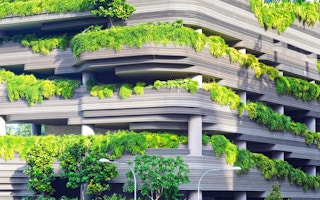It is the year 2500. In Singapore, We travel with driverless cars, Mars is a much-loved tourist spot, and robots live and walk among us as peers.
To continue reading, subscribe to Eco‑Business.
There's something for everyone. We offer a range of subscription plans.
- Access our stories and receive our Insights Weekly newsletter with the free EB Member plan.
- Unlock unlimited access to our content and archive with EB Circle.
- Publish your content with EB Premium.
But there is one catch: we’re all underwater, because sea levels have risen more than six metres, based on projections by some scientists.
Returning to present day, Singapore has just turned 52, and we probably should start thinking about how to avoid this watery fate.
The city-state’s meteoric economic rise over many decades has launched a landscape of towering skyscrapers in the compact island nation, and its buildings contribute to almost a quarter of all emissions here. Offices, shopping malls, hotels, education institutions and healthcare facilities consume almost a third of Singapore’s electricity.
The greenhouse gases and carbon emissions generated by these sectors are contributing to climate change and changing Singapore’s ecosystem’s natural processes, at an increasingly alarming rate.
The global fight against climate change is real, and Singapore, aptly nicknamed, the Garden City, might just have the potential to combat it through technology and green building design. While Singapore’s own emissions contribute only about 0.11 per cent of the global total, the nation’s acclaimed city-in-a-garden setting can be a role-model for other cities. In fact, Singapore has already exported its urban development expertise, notably to Tianjin Eco-city in China, and Amaravati in India.
The clean and green environment that Singaporeans enjoy and are so proud of, is part of a legacy left over from decades of the country’s leaders placing the highest priority on protecting the environment.
For a country that has signed the Paris Climate Change Agreement and been a vocal supporter of environment protection, building design can be a key opportunity to contribute. How does design come into play exactly? Can something that involves so much aesthetic content, make a noticeable dent in an issue as critical as global warming?
Garden City 2.0
An intensively urban community, Singapore uses a significant amount of energy.
But with the Building Construction Authority aiming for 80 per cent of buildings to be certified under the national Green Mark building certification scheme by 2030, and the awareness about climate change increasing every day, we are on the right track to turn that around.
Green buildings, designed to use resources more efficiently and cause minimal damage to the natural environment, have been hailed as a way to cope with the impact of climate change and reduce the environmental impact of urban living. Energy, water, indoor environmental quality, materials and so on are all taken into account in the buildings’ planning, design, and construction.
A few commercial buildings in Singapore have jumped on this green bandwagon – many urban planners now weave greenery throughout the city from green roofs that improve solar performance to cascading vertical gardens and verdant walls.
Just look at the architecture of the PARKROYAL on Pickering hotel, or the interior landscape of Food Garden in the Asia Square retail centre.
A modern skyscraper that uses less water and electricity
Asia Square has been oft upheld as a shining example – as host to the largest solar panel installation in Singapore at the Central Business District (CBD) area and the first bio-diesel plant in a commercial development in the heart of the city.
Even the dining space in its Food Garden has a green wall that contributes to the building’s LEED (Leadership in Energy and Environmental Design) and Green Mark Platinum status.
The wall is designed out of completely recyclable materials, and is water and energy efficient when it comes to self-maintenance. Condensed water droplets are collected from air handling units and used to water plants in toilets in the building, helping to achieve utility cost savings.
The results are telling. Asia Square performs in the top 10 per cent of buildings in Singapore, in terms of water efficiency, according to PUB, Singapore’s national water agency. Compared to other standard commercial buildings, Asia Square consumes 35 per cent less energy.
There is a common misconception that going green is costly, as green materials and products can be expensive.
The truth is that it does not need to be. Even if they do cost more initially, organisations should also balance these against the long-term savings they can reap.
More importantly, the best returns on these investments are realised when environmental considerations are integrated into the process at the start, rather than as a last-minute effort. Green building design must be thought of as an investment in the future. Every design element is a choice to reduce environmental impact while still being durable enough to prove functional.
“
Design can be the weapon to aid in the fight against climate change. And it is up to us to design a future where we are not all living underwater.
Designers can join the climate fight
The fight for climate change is not just the fight of building planners, large organisations or world leaders. It is a fight all of us are in, and losing will have colossal consequences.
Five simple tips that anyone, in particular, interior designers, can consciously incorporate are:
- Use light colours for building exteriors. The colour of buildings affect heat absorption. Light-coloured paint can help reflect the sun’s heat away from the building. According to Solar Today Magazine, white walls, for example, gain 35 per cent less heat than black walls, therefore requiring less energy to cool the building. Lighter-coloured and brighter aesthetics are thankfully also on trend.
- Maximise natural light. Singapore is blessed with an abundance of sunlight and making use of this can save huge amounts of energy and cost. For corporate buildings, position meeting rooms at the periphery, and use mirrors to reflect the light from windows. An open-plan office made possible by natural lighting can provide alternative work settings and collaborative areas for a conducive work environment.
- Leverage technology. With smart homes becoming the new norm, going green is easier than ever. Installing smart lighting that can be controlled with timers or light and motion sensors can decrease energy usage drastically. Smart home devices present the next step towards green buildings.
- Select, produce and install the right elements to promote sustainability. For instance, one could use linoleum rather than vinyl flooring, since linoleum is made substantially from jute, a naturally occurring fibre, and possesses natural bacteria-resistant properties that make it a perfect choice for the upkeep of spaces. Every finished product should incorporate strategies for reducing energy consumption and highlight opportunities for reducing, reusing, and recycling waste, including numerous recycling bins within the buildings.
- Work with clients and various stakeholders. Consider how to incorporate environmentally-friendly options. While not everyone might be invested in fighting climate change because of misconceptions or even ignorance, interior designers can play a part in involving climate change in the conversation.
Marrying design and sustainability
Singapore has pledged to reduce our emissions intensity by 36 per cent from the 2005 levels by 2030. While continuing to play our part in the global community, we must also ensure that the fight against climate change starts from within.
With regular events such as the annual Singapore Green Building Week, Singapore has a strong community which seeks to catalyse behavioural change at the individual, interpersonal and national levels. Now, more than ever, is a good time to think about what exactly is needed to step up our game as a green city.
Furthermore, sustainability is also about integrating constructed and living systems. Most of us are not radical environmentalists, but all of us want a sustainable future.
We have the opportunity to create man-made structures that could enhance, not destroy, the existing landscape. Designers therefore have a responsibility to find ways to balance aesthetics and functionality with choices to reduce the environmental impact.
From something as seemingly frivolous as changing colours, to something more strategic like working with various stakeholders to make calculated, eco-friendly plans, design can pave the way to a greener future.
When designers make the conscious decision to choose finishes, furniture and lighting that are sustainable, we increase our chances of having a better quality of life.
Design can be the weapon to aid in the fight against climate change. And it is up to us to design a future where we are not all living underwater.
Derek MacKenzie is managing director of designphase dba which has designed buildings like the new Tiong Bahru Plaza, Grand Copthorne Waterfront and Commonwealth Australian Bank. This article was written exclusively for Eco-Business.











